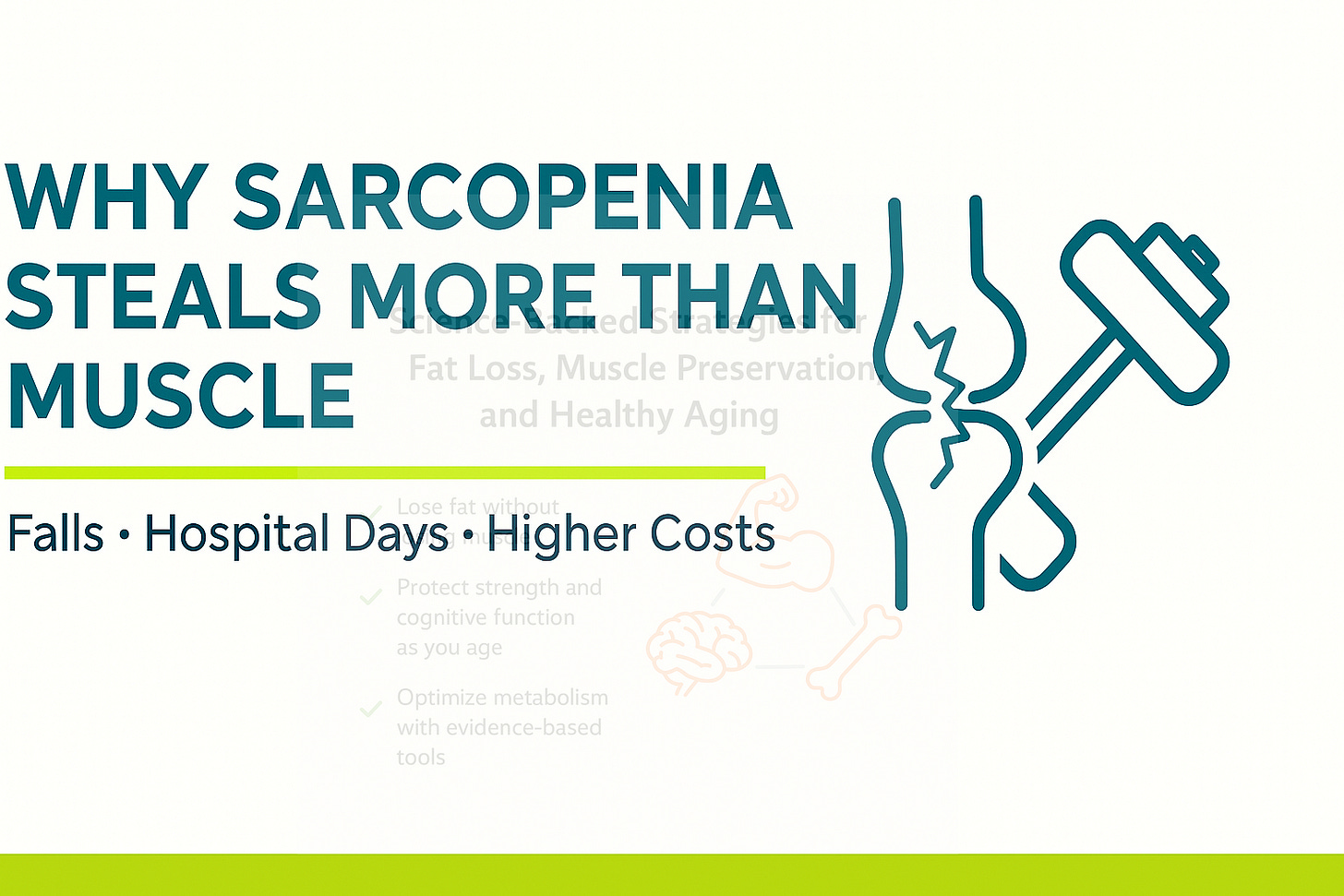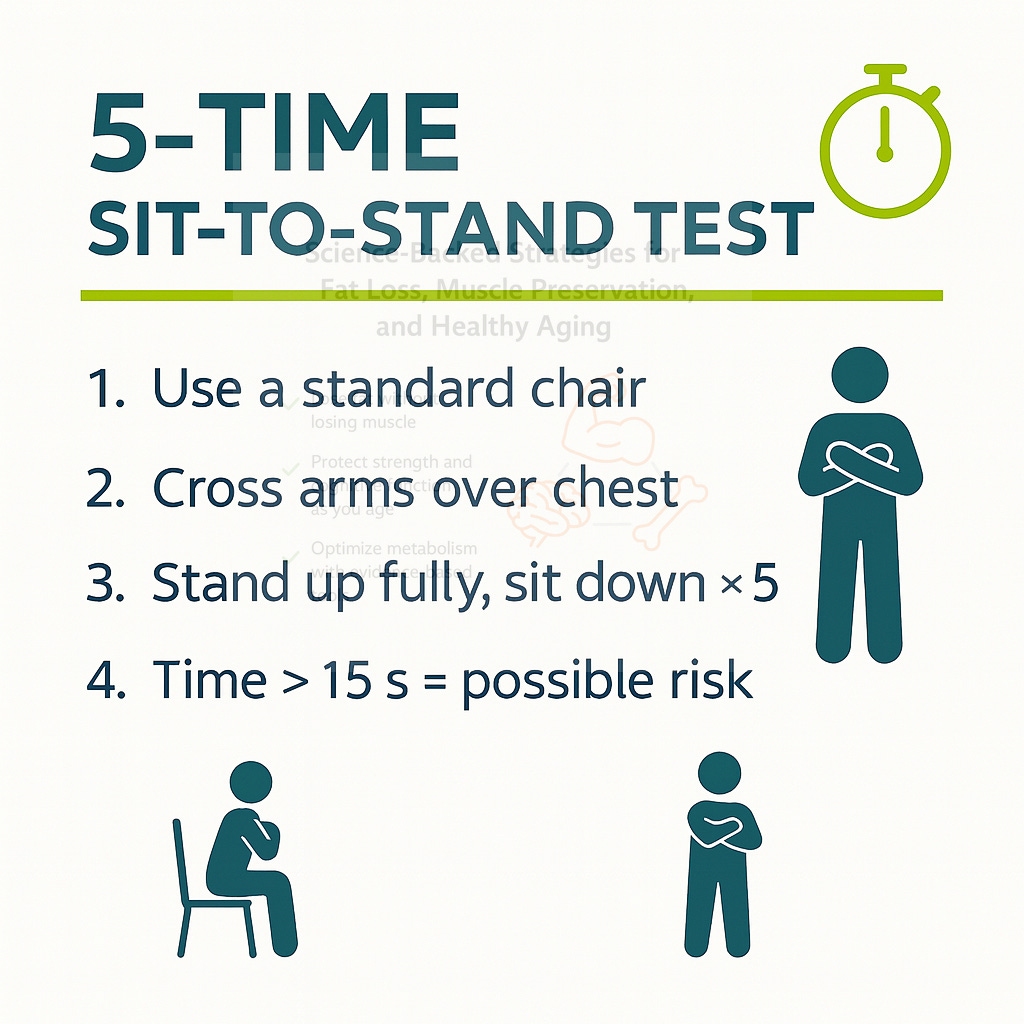Why Sarcopenia Steals More Than Muscle
Falls, hospital days, higher costs and why early muscle loss changes everything
Dorothy’s Wake-Up Call
Dorothy, 72, managed housework, weekly shopping with two grocery bags, and dog walks twice a week. After moving into a one-story home she noticed the few steps she once handled easily now felt taxing. At the zoo with her grandkids she needed to sit and rest halfway through the day. Weeks later she slipped on a curb, broke her hip, and spent two weeks in rehabilitation. The surgeons fixed the bone but rehab staff flagged a deeper issue: her grip strength was 12 kg, well below the healthy cut-off. Dorothy had not just lost bone; she had lost the muscle that stabilizes and protects it.
Sarcopenia rarely kills directly yet it magnifies every threat to healthy aging. Today we answer one question: why does muscle loss matter so much?
Why Muscle Loss Matters
Muscle powers every routine task—standing, carrying groceries, catching yourself when you slip. When strength drops, risks soar.
The Economic Shockwave
Hip fractures alone drive enormous costs:
$5.96 billion in annual Medicare spending on intertrochanteric fractures³
76 percent of those costs occur in the first 90 days, mainly for skilled-nursing and inpatient care³
Each additional hospital day adds about $1 200 to the bill³
Preventing sarcopenia delivers both health and economic dividends.
Mechanisms You Can Measure
Understanding why sarcopenia amplifies risk reveals actionable targets:
Fast-twitch fiber loss
Those “catch-me” fibers thin first with age and inactivity⁵Chronic inflammation
Type 2 diabetes doubles sarcopenia risk in older adults⁶Metabolic impact
Skeletal muscle disposes of 70 percent of post-meal glucose; less muscle means higher blood sugar and more visceral fat⁷
Muscle is your body’s largest endocrine and metabolic organ—not vanity tissue.
Screen Early – Four Simple Tests
Add these to an annual wellness exam for fast, actionable data:
SARC-F questionnaire
Five self-scored questions on strength, walking assistance, chair-rise, stair climbing, and falls. A score ≥ 4 flags high risk⁸Grip dynamometer
Measures maximal hand-grip strength in under 30 seconds. Under 27 kg for men or 16 kg for women predicts mobility decline⁶Five-chair-stand test
Time yourself rising from a standard chair five times with arms folded. More than 15 seconds predicts low function and correlates with fall risk⁸PowerFrail app assessment
Smartphone assessment of sit-to-stand power and grip tasks in under two minutes. Measures relative muscle power, a robust predictor of mobility and fall risk²
Each of these outperforms BMI for predicting sarcopenia and fits easily into a standard exam
SARC-F Scoring key:
0 = no difficulty (or no falls)
1 = some difficulty (or 1–3 falls)
2 = a lot of difficulty or unable (or ≥ 4 falls)
Problem · Agitation · Solution
Problem
Most patients and many clinicians wait for the first fall or fracture before diagnosing sarcopenia.
Agitation
After that first fracture, one-year mortality rises 27 percent and each hospital readmission adds thousands of dollars and weeks of recovery³
Solution
Screen early – integrate SARC-F into every annual exam, then confirm with grip, sit-to-stand, or PowerFrail
Strength train twice per week – high-intensity protocols increased leg strength by 174 percent and thigh muscle area by 9 percent in nonagenarians over eight weeks⁵
Protein 1.2–1.6 g·kg⁻¹·day⁻¹ – intakes above the RDA blunt anabolic resistance, fuel repair, and preserve lean mass⁷
These three levers remain the most powerful interventions in geriatric care.
Coming Tomorrow
Day 4 delivers the Exercise Blueprint, a four-week progressive resistance program with printable logs for every subscriber.
What surprised you most about why sarcopenia matters? Comment below—your insight may help someone catch an early warning sign.
Subscribe now so the Exercise Blueprint lands in your inbox tomorrow.
This was day 3 of 7. If you missed days 1 and 2 then here are the links:
Fight for Independence
Marjorie is 67, still juggling part-time work and grand-kid duty. Last month she whispered, “Groceries take two trips now.” Routine labs looked fine. There had been no illness or injury. The real issue, never mentioned by her prior clinicians, was sarcopenia: age-related loss of muscle mass
References
Yeung SSY et al. Sarcopenia and its association with falls and fractures in older adults: a systematic review and meta-analysis. J Cachexia Sarcopenia Muscle. 2019;10(3):485–500. doi:10.1002/jcsm.12411. PMID:30993881; PMCID:PMC6596401
BJSportsMedicine. App review – PowerFrail for the assessment of relative muscle power and frailty in older people. BMJ Sports Med Blog. February 4, 2021. https://blogs.bmj.com/bjsm/2021/02/04/app-review-powerfrail-for-the-assessment-of-relative-muscle-power-and-frailty-in-older-people/
Adeyemi A, Delhougne G. Incidence and economic burden of intertrochanteric fracture: a Medicare claims database analysis. JB JS Open Access. 2019;4(1):e0045. doi:10.2106/JBJS.OA.18.00045. PMID:31161153; PMCID:PMC6510469
Zhang X et al. Association of sarcopenic obesity with the risk of all-cause mortality among adults: an updated meta-analysis. BMC Geriatr. 2019;19:183. doi:10.1186/s12877-019-1195-y. PMID:31353439; PMCID:PMC6657267
Fiatarone MA et al. High-intensity strength training in nonagenarians: effects on skeletal muscle. JAMA. 1990;263(22):3029–3034. PMID:2342214
Massimino E et al. Risk of sarcopenia and associated factors in older adults with type 2 diabetes: an exploratory cross-sectional study. Healthcare (Basel). 2023;11(14):2081. doi:10.3390/healthcare11142081. PMID:37510524; PMCID:PMC10380017
Phillips SM et al. Protein “requirements” beyond the RDA: implications for optimizing health. Appl Physiol Nutr Metab. 2016;41(5):565–572. doi:10.1139/apnm-2015-0550. PMID:26960445
Malmstrom T et al. SARC-F: a simple questionnaire to rapidly diagnose sarcopenia. J Am Med Dir Assoc. 2013;14(8):531–532. doi:10.1016/j.jamda.2013.05.018. PMID:23856151










Working in a supermarket the number of women who ask me to pack their bags lightly is concerning. Also some ask bc of stairs in their house. Some walk in with a walker, some need to sit down, some are hunched over & some with a cane. The number of online shopping for groceries is popular (may cause less incidental activity for those ordering). An Uber driver was buying for a customer telling me he does a lot of buying for customers of other business too ie chemist, Kmart, target.
Muscle being a deposit for glucose matters thus the antithesis is sarcopenia.
Thank goodness you are highlighting sarcopenia as awareness is something I can work & strive towards slowing down. Thx.
This is a massive issue! Thank you!